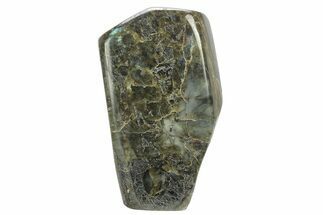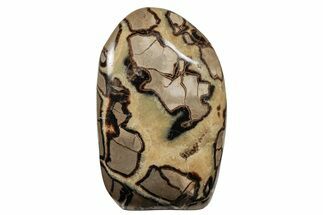This Specimen has been sold.
Lot: 25 Lbs Free-Standing Polished Labradorite - 12 Pieces
This is a wholesale lot of 25 lbs of beautiful, polished labradorite from Madagascar. The lot is made up of 12 pieces measuring from approximately 4 to 6" across/tall. The quality varies from piece to piece but in general this lot has great color play and Labradorescence. Each piece has one side which is cut flat allowing them to stand upright on a flat surface and create a beautiful display
On average these pieces can easily retail for several times the wholesale price. You will receive the exact lot pictured
On average these pieces can easily retail for several times the wholesale price. You will receive the exact lot pictured
About Labradorite
Labradorite is a feldspar mineral most often found in mafic igneous rocks. Some specimens of labradorite exhibit what is called a "Schiller effect"; a strong play of iridescent blue, green, red, orange, and yellow colors. Labradorite is so well known for these spectacular displays of color that the phenomenon is also known as labradorescence. Specimens with high quality labradorescence are often polished and used as gemstones.
The labradorescence is not caused by the colors breflecting on the surface of the specimen. Instead, light enters the stone, hits a twinning crystal lattice surface within the stone, and reflects from that. The color seen is the color of light reflected from that twinning surface. Different twinning surfaces within the stone reflect different colors of light. Light reflecting from different twinning surfaces in various parts of the stone can give the stone a multi-colored appearance.
Labradorite is named after Labrador, Canada, where it was first found. Today, the most prolific deposits for most commercially available labradorite occur in Madagascar and Russia.
Labradorite is a feldspar mineral most often found in mafic igneous rocks. Some specimens of labradorite exhibit what is called a "Schiller effect"; a strong play of iridescent blue, green, red, orange, and yellow colors. Labradorite is so well known for these spectacular displays of color that the phenomenon is also known as labradorescence. Specimens with high quality labradorescence are often polished and used as gemstones.
The labradorescence is not caused by the colors breflecting on the surface of the specimen. Instead, light enters the stone, hits a twinning crystal lattice surface within the stone, and reflects from that. The color seen is the color of light reflected from that twinning surface. Different twinning surfaces within the stone reflect different colors of light. Light reflecting from different twinning surfaces in various parts of the stone can give the stone a multi-colored appearance.
Labradorite is named after Labrador, Canada, where it was first found. Today, the most prolific deposits for most commercially available labradorite occur in Madagascar and Russia.
SPECIES
Labradorite
LOCATION
Madagascar
SIZE
25 lbs, 12 pieces, Most pieces 4 to 6" across/tall
CATEGORY
ITEM
#78028
 Reviews
Reviews















